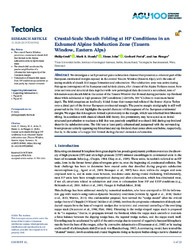Crustal‐Scale Sheath Folding at HP Conditions in an Exhumed Alpine Subduction Zone (Tauern Window, Eastern Alps)
DOI: https://doi.org/10.1029/2019TC005942
Persistent URL: http://resolver.sub.uni-goettingen.de/purl?gldocs-11858/8521
Persistent URL: http://resolver.sub.uni-goettingen.de/purl?gldocs-11858/8521
Groß, Philip; Handy, Mark R.; John, Timm; Pestal, Gerhard; Pleuger, Jan, 2020: Crustal‐Scale Sheath Folding at HP Conditions in an Exhumed Alpine Subduction Zone (Tauern Window, Eastern Alps). In: Tectonics, Band 39, 2, DOI: 10.1029/2019TC005942.
 |
Dokument öffnen: |
We investigate a well‐preserved paleo subduction channel that preserves a coherent part of the European continental margin exposed in the central Tauern Window (Eastern Alps), with the aim of testing models of sheath fold nappe formation and exhumation. The subduction zone was active during Paleogene convergence of the European and Adriatic plates, after closure of the Alpine Tethyan ocean. New cross sections and structural data together with new petrological data document a recumbent, tens of kilometers‐scale sheath fold in the center of the Tauern Window that formed during pervasive top‐foreland shear while subducted at high‐pressure (HP) conditions (~2.0 GPa, 500 °C) close to maximum burial depth. The fold comprises an isoclinally folded thrust that transported relicts of the former Alpine Tethys onto a distal part of the former European continental margin. The passive margin stratigraphy is still well preserved in the fold and highlights the special character of this segment of the European continental margin. We argue that this segment formed a promontory to the margin, which was inherited from Mesozoic rifting. In accordance with classical sheath fold theory, this promontory may have acted as an initial structural perturbation to nucleate a fold that was passively amplified to a sheath fold during top‐foreland shear in the subduction zone. The fold was at least partly exhumed and juxtaposed with the surrounding lower pressure units by opposing top‐hinterland and top‐foreland shear zones above and below, respectively, that is, in the sense of a nappe fold formed during channel‐extrusion exhumation. Key Points:
The central Tauern Window preserves a crustal‐scale sheath fold that formed in the Alpine subduction zone in top‐foreland shear.
The sheath fold was formed by passive amplification of a rift‐inherited heterogeneity of the European margin.
Exhumation of sheath fold nappe from HP conditions was achieved at least partly by channel extrusion.
Statistik:
ZugriffsstatistikSammlung:
- Geologie [933]
Schlagworte:
sheath foldexhumation
high‐pressure metamorphism
Alps
channel extrusion
orogenic wedge
This is an open access article under the terms of the Creative Commons Attribution License, which permits use, distribution and reproduction in any medium, provided the original work is properly cited.

